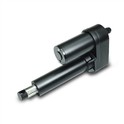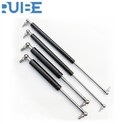Hey there! As a supplier of Gas Spring for Chair, I've been getting a lot of questions lately about whether gas springs for chairs lose pressure over time. So, I thought I'd write this blog to share some insights on this topic.
How Gas Springs Work in Chairs
First off, let's understand how gas springs work in chairs. A gas spring is basically a cylinder filled with nitrogen gas and a small amount of oil. It uses the compressibility of gas to provide a smooth and controlled motion. When you sit on a chair, the gas spring compresses, and when you get up, it extends back to its original position. This mechanism allows you to adjust the height of the chair easily and provides support while you're sitting.
The gas inside the spring is under pressure, and this pressure is what gives the spring its ability to function. The pressure is carefully calibrated during the manufacturing process to ensure that the chair provides the right amount of support and adjustability.
Do They Lose Pressure Over Time?
The short answer is yes, gas springs for chairs can lose pressure over time. There are a few reasons for this.
Natural Leakage
One of the main reasons is natural leakage. Even though gas springs are designed to be airtight, over time, a small amount of gas can seep out through the seals. This is a slow process, but it can eventually lead to a noticeable loss of pressure. The quality of the seals plays a big role here. Higher - quality seals are better at preventing leakage, but they're not completely immune.
Wear and Tear
Another factor is wear and tear. As you use the chair regularly, the gas spring is constantly being compressed and extended. This repeated motion can cause the internal components of the gas spring to wear down. The piston, for example, may start to develop small scratches or grooves, which can allow gas to escape more easily. Also, the seals can get damaged or deformed over time, leading to increased leakage.
Environmental Factors
Environmental factors can also have an impact. Extreme temperatures can affect the pressure inside the gas spring. In cold temperatures, the gas contracts, which can make the chair feel stiffer. In hot temperatures, the gas expands, and if the spring is already close to its maximum pressure limit, it may cause some gas to leak out. Humidity can also cause corrosion of the metal parts of the gas spring, which can further compromise its integrity.
Signs That a Gas Spring Has Lost Pressure
So, how can you tell if a gas spring in your chair has lost pressure?
Difficulty in Adjusting Height
If you find it harder to adjust the height of the chair or if the chair doesn't stay at the height you set it to, it could be a sign of low pressure. When the pressure is low, the spring may not be able to support the weight of the person sitting on the chair properly, and it may slowly sink down.
Uneven Movement
Another sign is uneven movement. If the chair jerks or moves in an irregular way when you sit or stand up, it might be because the gas spring is not providing a smooth and consistent force. This could be due to a loss of pressure or a problem with the internal components of the spring.
Sagging Chair
A visibly sagging chair is also a clear indication. If the seat of the chair is lower than it used to be and doesn't bounce back properly when you get up, the gas spring is likely losing pressure.
How to Prolong the Life of Gas Springs
As a supplier, I always want my customers to get the most out of our Gas Spring for Chair. Here are some tips to prolong the life of your chair's gas spring.
Regular Maintenance
Regular maintenance is key. Keep the chair clean and free of dust and debris. Wipe down the gas spring and the surrounding area regularly. You can also lubricate the moving parts of the gas spring with a silicone - based lubricant. This helps reduce friction and wear on the internal components.
Avoid Overloading
Don't overload the chair. Each gas spring is designed to support a certain weight capacity. If you regularly exceed this capacity, it will put extra stress on the gas spring and increase the chances of wear and tear and pressure loss.
Store in a Suitable Environment
Store the chair in a suitable environment. Avoid exposing it to extreme temperatures and high humidity. If possible, keep the chair in a climate - controlled room.
Our Gas Spring Products
At our company, we offer high - quality Gas Spring for Chair. We use top - notch materials and advanced manufacturing techniques to ensure that our gas springs have excellent sealing and durability. Our gas springs are designed to minimize natural leakage and resist wear and tear.


In addition to Gas Spring for Chair, we also have other products like Sofa Gas Spring and Gas Spring for Medical Bed. These products are also made with the same high standards of quality and performance.
Contact Us for Purchasing
If you're in the market for gas springs for your chairs, sofas, or medical beds, we'd love to hear from you. Whether you're a furniture manufacturer or just looking to replace a worn - out gas spring in your own chair, we can provide you with the right products at competitive prices. Reach out to us to start a purchasing discussion, and let's find the perfect gas spring solution for your needs.
References
- "Gas Spring Technology Handbook" - A comprehensive guide on gas spring design and performance.
- Research studies on the effects of environmental factors on gas spring integrity.
So, that's all about whether gas springs for chairs lose pressure over time. I hope this blog has been helpful to you. If you have any more questions, feel free to ask!






